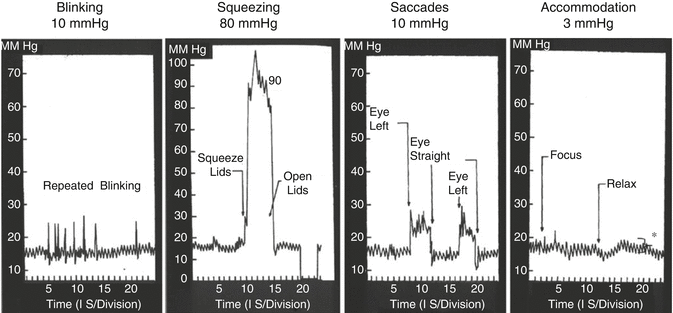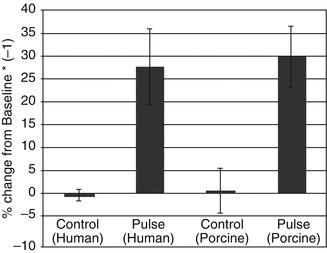and Renata Fortuna Ramos3
(2)
Department of Ophthalmology and Vision Science, The University of Arizona, Tucson, AZ, USA
(3)
Department of Bioengineering, Rice University, Houston, TX, USA
Because pathology associated with ocular hypertension resides in the conventional drainage pathway, research studies have focused on understanding how resistance to outflow is regulated in order to develop better pharmacological treatments for glaucoma. Much of the work to date has examined functional, morphological, and biochemical changes in conventional drainage tissues, including the trabecular meshwork and Schlemm’s canal, in response to elevated IOP. Unfortunately, little is known about the contribution of dynamic changes in pressure to outflow resistance regulation.
As the name implies, aqueous humor dynamics are not static, but an orchestra of physiological processes in the human eye responsible for aqueous humor circulation and the generation of IOP. These dynamic processes result in pressure changes that occur over second to day time scales to regulate IOP. Unfortunately, most studies to date have only examined physiological consequences of static IOP elevations and neglected IOP alterations during the day (circadian rhythm), with each heartbeat (ocular pulse), with changes in posture (sitting vs. standing), with changes in ciliary muscle tone (accommodation), and with other daily activities (blinking, sneezing, squeezing, eye movement, etc.). Interestingly, depending upon the activities/processes, IOP can be transiently or repetitively altered between 3 and 100 mmHg in seconds (Fig. 2.1).


Fig. 2.1
Intraocular pressure oscillations recorded from a living human eye during different ocular activities. Bracket marked by asterisk in right panel highlights ocular pulse that is prevalent throughout measurements [Modified from Singh and Shrivastava [1]. With permission from Wolter Kluwers Health]
The conventional drainage tissues are thought to be responsible for regulating outflow facility, both accommodating to rapid changes in pressure (short-term regulation) as well as maintaining IOP within a narrow range on the order of days to decades (long-term regulation). While the contribution of physiological IOP oscillations to long-term regulation of conventional outflow is unknown, recent data shows that IOP oscillations similar in magnitude to ocular pulsations in vivo (3 mmHg at 1 Hz) significantly alter outflow facility (IOP) in both porcine and human eyes (Fig. 2.2). Studies using organ-cultured anterior eye segments showed a 30 % decrease in conventional outflow facility in response to fluctuations in IOP over the span of a few hours. The decrease in outflow facility was shown not to be due to damage to conventional tissues. In fact, the cellularity of conventional drainage tissues exposed to IOP oscillations was significantly greater than that of tissues exposed to a static IOP gradient, suggesting that cells are both healthy and functionally respond to mechanical stress. In terms of mechanism of action, it appears that ocular pulse modifies the level of contractility (tone) of trabecular meshwork cells to decrease the outflow facility (increase resistance). In retrospect, such a result was not surprising, considering the importance of trabecular meshwork cell contractility in outflow facility regulation and its potential usefulness as a target of novel glaucoma therapeutics currently in clinical trials.


Fig. 2.2
Outflow facility changes in response to cyclic oscillations
Similar to known importance of repetitive cyclic mechanical stress in controlling homeostasis in other tissues (i.e., cardiovascular and bone physiology), it appears that the conventional outflow pathway is no different. Ocular pulse (and likely other stimuli like circadian changes in IOP) appears important in “grooming” conventional outflow cells to help set contractile tone and subsequently impact the IOP setting. An interesting area of research for the future is to understand whether people who develop ocular hypertension and ultimately glaucoma have aberrant responses of conventional outflow tissues (and possibly optic nerve head tissues) over time to such repetitive mechanical queues.
This affords us another way of looking at glaucoma. Is repetitive mechanical stimulation important in the maintenance of IOP? The data here provides some of the first evidence that moment to moment changes in eye pressure may actually be important. Physiologically, this makes a great deal of sense. Further, clinicians often forget that accommodation, blinking, squeezing, and even saccades all have an effect on IOP. All of these may be important in maintaining eye pressure, and some have even speculated that such fluctuations are important in maintaining the health of other ocular structures such as the optic nerve.
Stay updated, free articles. Join our Telegram channel

Full access? Get Clinical Tree


